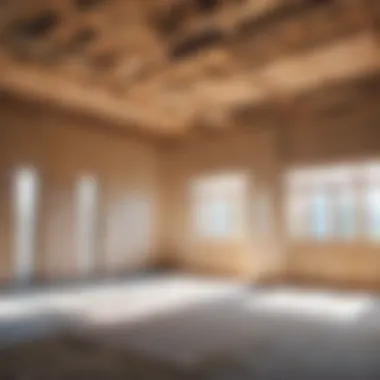Materials:
- Hydraulic jacks: 12 units (each measuring 12 inches)
- Steel support beams: 6 beams (10 feet in length, 6 inches in width)
- Heavy-duty cribbing: 30 blocks (10 inches x 10 inches x 10 inches)
- Shoring equipment: 4 sets
- Leveling laser: 1 unit
- Screw jacks: 4 units
- Safety gear: hard hats, gloves, goggles
DIY Steps:
- Initial Assessment: Conduct a thorough inspection of the building's foundation and structural integrity to determine the extent of work needed.
- Permit Acquisition: Obtain all necessary permits and approvals from local authorities before commencing any lifting activities.
- Preparation: Clear the area around the house, remove any obstacles, and secure the work zone to ensure safety.
- Positioning: Place the hydraulic jacks at strategic points around the house, ensuring even weight distribution.
- Lifting: Gradually elevate the house using the hydraulic jacks while monitoring the progress with a leveling laser.
Technical Aspects:
- Timing Specifics: Lift the house slowly and steadily, ensuring no sudden movements that could compromise the structure.
- Critical Techniques: Implement a synchronized lifting technique to maintain balance and prevent any structural damage.
- Tools: Use screw jacks for fine adjustments and ensure all equipment is in optimal working condition.
DIY Project Process:


- Installation Method: As the house is lifted, slide the steel support beams underneath for added stability and support.
- Key Techniques: Maintain communication among the team members to coordinate lifting activities smoothly and efficiently.
- Timings: Adhere to the predetermined lifting schedule and make adjustments as needed to avoid delays.
- Troubleshooting Tips: In case of uneven lifting, readjust the hydraulic jacks and verify the leveling laser's accuracy.
Stay tuned for our next sections detailing the structural modifications, finishing touches, and enjoying the elevated house!
Understanding the Concept of House Lifting


House lifting is a specialized process that involves elevating an entire building to address various structural issues and create additional space. The significance of understanding the concept of house lifting cannot be overstated in this comprehensive guide. By comprehending the intricacies of this procedure, house owners can make informed decisions about the structural modifications necessary for their property. Additionally, understanding house lifting helps in ensuring the safety and integrity of the building, essential aspects when considering such a significant endeavor.
What Does House Lifting Entail?
Structural Modifications
Structural modifications play a crucial role in the house lifting process, involving alterations to the building's foundation and framework to facilitate elevation. One key characteristic of structural modifications is their ability to strengthen the existing structure, ensuring its stability during and after the lifting process. Implementing structural modifications is a popular choice in house lifting projects due to their effectiveness in correcting foundation issues and improving the overall structural integrity. Despite the advantages of structural modifications, it's important to consider their potential disadvantages such as cost implications and the need for professional expertise in execution.
Elevating the Entire Building
Elevating the entire building is a fundamental aspect of house lifting, where the entire structure is raised above its current foundation level. The key characteristic of this process is the creation of space underneath the building, offering potential for additional functionalities or resolving foundation-related concerns. Elevating the entire building is a popular choice for house lifting projects seeking to address issues like flooding, poor foundation conditions, or the desire for extra usable space. While this technique offers numerous benefits, it's important to acknowledge potential disadvantages such as increased construction complexities and longer project durations.
Reasons for House Lifting
Foundation Repairs
Foundation repairs are a critical aspect of house lifting, aimed at addressing structural issues in the building's foundation. The key characteristic of foundation repairs lies in rectifying foundation damage or instability, ensuring the structure's long-term durability. Opting for foundation repairs in house lifting projects is a beneficial choice as it helps in restoring the foundation's integrity and mitigating risks of further damage. However, it's essential to note the potential disadvantages like the extent of foundation damage affecting repair costs and project timelines.
Creating Additional Space
Creating additional space underneath the house is a common reason for house lifting, allowing homeowners to maximize their property's utility. The key characteristic of this aspect is the expansion of living or storage space without altering the property's footprint. Choosing to create additional space during a house lifting project is advantageous for homeowners seeking to enhance their property's functionality and value. Despite the benefits, considerations like construction costs and regulatory approvals need to be factored in, highlighting potential disadvantages of increasing project expenses and approval delays.
Importance of Professional Expertise
Ensuring Structural Stability
Ensuring structural stability through professional expertise is a critical component of successful house lifting projects. The key characteristic of this aspect is the reliance on experienced professionals to assess, plan, and execute the required structural modifications. Seeking professional expertise in ensuring structural stability is beneficial as it guarantees the structural integrity of the building and minimizes risks during the lifting process. While the expertise of professionals is invaluable, it's essential to be aware of the potential disadvantages such as increased project costs associated with professional services.
Compliance with Building Codes
Compliance with building codes is paramount in house lifting projects to adhere to regulatory standards and ensure the safety of the structure. The key characteristic of this aspect is the alignment of construction practices with local building regulations and guidelines. Prioritizing compliance with building codes in house lifting is a beneficial choice as it reduces legal liabilities and enhances the overall quality of the project. Despite the advantages, challenges like complex permit procedures and regulatory changes may pose potential disadvantages, necessitating thorough planning and regulatory awareness.
Initial Preparations for House Lifting


House lifting is a complex and delicate process that requires meticulous planning and preparation to ensure the safety and success of the project. This section of the article sheds light on the critical steps involved in the initial preparations for house lifting.
Site Evaluation and Inspection
Before embarking on the journey of lifting a house, a thorough site evaluation and inspection are paramount. This phase sets the foundation for the entire lifting process by providing valuable insights into the existing conditions of the property.
Assessing Foundation Conditions
One of the key aspects of site evaluation is assessing the foundation conditions of the house. This involves inspecting the stability, strength, and integrity of the current foundation to determine its ability to support the lifting process. Assessing foundation conditions helps in identifying potential weaknesses or vulnerabilities that need to be addressed during the lifting operation.
Identifying Potential Risks
Another crucial element of site evaluation is identifying potential risks associated with the house lifting project. This includes assessing factors such as structural integrity, soil composition, and surrounding environment to determine any potential hazards that may impact the lifting process. By identifying risks beforehand, preventive measures can be implemented to mitigate any potential issues that may arise.
Obtaining Permits and Approvals
In the realm of house lifting, obtaining the necessary permits and approvals is a non-negotiable step in the process. Adhering to local regulations and building codes is imperative to ensure legal compliance and the safety of the project.
Local Regulations
Local regulations play a vital role in dictating the requirements and restrictions for house lifting projects. Understanding and following these regulations are essential to avoid legal complications and ensure that the project meets all necessary standards. Local regulations may encompass aspects such as zoning laws, environmental considerations, and safety protocols.
Building Permits
Securing building permits is a crucial part of the pre-lifting preparations. These permits grant official approval for the house lifting project to proceed and validate that the project meets all structural and safety requirements. Obtaining building permits demonstrates a commitment to following established guidelines and protocols, instilling confidence in the project's legitimacy.
Creating a Comprehensive Plan
A comprehensive plan serves as the blueprint for a successful house lifting endeavor, outlining the details and logistics of the project from start to finish.
Engineering Design
The engineering design phase is where the technical aspects of the lifting process are fleshed out. This includes structural calculations, weight distribution analysis, and material specifications to ensure the safe and effective elevation of the house. Engineering design lays the groundwork for the execution of the lifting operation, mapping out the intricate details required for a successful outcome.
Logistical Details
Logistical details encompass the practical considerations and arrangements essential for carrying out the lifting process seamlessly. From scheduling and coordinating workers to procuring equipment and securing resources, logistical details cover the operational aspects needed to execute the plan efficiently. Attention to logistical details minimizes delays, optimizes resource utilization, and ensures that the project progresses according to schedule.
Execution of House Lifting Process
House lifting is a complex and intricate procedure that requires careful planning and execution to ensure the successful elevation of a structure. In the context of this article, the section on the execution of house lifting process plays a crucial role in shedding light on the practical steps involved in safely raising a house. By focusing on specific elements such as preparatory measures, lifting techniques, monitoring, and safety protocols, this part of the guide provides a detailed roadmap for homeowners and professionals alike. Understanding the significance of each stage within the execution process is paramount to achieving a seamless house lifting experience.
Preparatory Steps
Clearing the Area Around the House
Clearing the area around the house is a critical initial step in the house lifting process. It involves removing obstacles and debris to create a safe and unobstructed environment for the lifting operation. This step contributes significantly to the overall goal of ensuring a smooth and successful house elevation. The key characteristic of clearing the area is its ability to enhance the efficiency and safety of the lifting process. By eliminating potential hazards and obstructions, clearing the area enables unhindered access for equipment and personnel involved in the operation. Despite being a labor-intensive task, the advantages of a well-cleared site, such as minimizing risks of accidents and ensuring optimal working conditions, make it an indispensable choice for any house lifting endeavor.
Securing Utilities
Securing utilities is another crucial preparatory step before initiating the house lifting process. This phase involves safely disconnecting and securing essential services such as electricity, water, and gas to prevent any accidents or disruptions during the lifting operation. The key characteristic of securing utilities lies in the necessity to safeguard both the property and the individuals involved in the lifting process. By ensuring that utilities are properly managed and isolated, the risk of potential hazards or damages is significantly reduced. While this step may introduce temporary inconveniences, the benefits of mitigating safety hazards and preserving the integrity of utility systems underscore its importance in the overall success of the house lifting endeavor.
Lifting Techniques
Jacking and Shoring
Jacking and shoring are fundamental techniques employed in the house lifting process to raise and support the structure effectively. Jacking refers to the method of lifting the house using hydraulic jacks, while shoring involves providing additional support to ensure the stability of the elevated building. The key characteristic of jacking and shoring lies in their versatility and precision in facilitating controlled elevation and structural reinforcement. By utilizing these techniques, professionals can carefully lift and stabilize the house according to precise measurements and engineering calculations. While labor-intensive, the advantage of jacking and shoring lies in their effectiveness in achieving a structurally sound elevation while minimizing risks associated with uneven lifting or structural instability.
Hydraulic Lifting Systems
Hydraulic lifting systems are integral components of modern house lifting operations due to their efficiency and precision in raising heavy structures. These systems utilize hydraulic pressure to elevate buildings smoothly and evenly, ensuring a uniform lift across all support points. The key characteristic of hydraulic lifting systems is their ability to provide controlled and synchronized elevation, minimizing the risk of structural strain or damage during the lifting process. Their unique feature lies in the advanced technology that allows operators to adjust the lifting speed and height with precision, contributing to a safer and more stable house lifting experience. While the initial investment in hydraulic systems may be higher, the advantages of their reliable performance and accuracy make them a preferred choice for successful house lifting projects.
Monitoring and Safety Measures
Constant Monitoring of Progress
Constant monitoring of progress is essential during the house lifting process to track the elevation and ensure the stability of the structure. This aspect involves regular assessments and measurements to verify that the lifting operation is proceeding as planned. The key characteristic of constant monitoring lies in its role in detecting any irregularities or deviations from the intended lifting path, allowing swift adjustments to maintain structural integrity. This feature is beneficial as it provides real-time feedback on the lifting process, enabling timely interventions to address any potential issues and prevent structural complications. While demanding continuous attention, the advantage of constant monitoring is the proactive identification of problems, leading to a smoother and safer house lifting operation.
Emergency Protocols
Implementing comprehensive emergency protocols is vital to handle unforeseen incidents or complications that may arise during the house lifting process. These protocols outline clear procedures and contingency plans to address emergencies such as equipment failure, sudden structural shifts, or adverse weather conditions. The key characteristic of emergency protocols is their ability to enable quick and effective responses to mitigate risks and ensure the safety of personnel and property. Their unique feature lies in establishing predefined actions and communication channels to promote coordinated and efficient emergency responses. While hopefully rarely used, the advantages of having robust emergency protocols in place are invaluable in safeguarding lives, minimizing damages, and maintaining operational continuity throughout the house lifting endeavor.
Post-Lifting Considerations
Post-lifting considerations play a vital role in the overall success and longevity of a house lifting project. Once a house has been lifted for various reasons such as foundation repairs or creating additional space, it is crucial to focus on the post-lifting phase to ensure the structural integrity and safety of the lifted structure. Foundation reinforcement, structural adjustments, and final inspections are key elements to address post-lifting.
Foundation Reinforcement
Installing Additional Supports
Installing additional supports is a critical aspect of foundation reinforcement after lifting a house. These supports are designed to bear the increased load of the lifted structure and provide stability. This process involves strategically placing additional beams, columns, or piers to distribute the weight evenly and prevent structural failures. The key characteristic of installing additional supports lies in its ability to strengthen the foundation and prevent future settling or shifting. While this process may add to the initial cost of lifting a house, it is a popular choice for ensuring long-term structural stability and safety.
Realigning Foundation Components
Realigning foundation components is another essential aspect of foundation reinforcement post-lifting. This process involves adjusting or repairing any misaligned or damaged foundation elements to ensure the structural integrity of the lifted house. By realigning foundation components, any existing issues with the foundation can be addressed, thereby enhancing the overall stability of the structure. The unique feature of this process is its ability to rectify foundation problems effectively, which can prolong the lifespan of the lifted house. While realigning foundation components adds to the post-lifting tasks, its advantages in preventing future structural issues make it a valuable investment.
Structural Adjustments
Leveling the House
Leveling the house post-lifting is a crucial step to ensure that the entire structure is balanced and supported evenly. This process involves using specialized equipment to adjust the elevation of the lifted house so that it sits level on its new foundation. The key characteristic of leveling the house is its ability to prevent uneven settling or structural strains, which can lead to further damage over time. This method is popular for its effectiveness in maintaining the structural integrity of the lifted house and preventing potential safety hazards.
Addressing Structural Damage
Addressing any structural damage post-lifting is imperative to safeguard the stability and safety of the lifted house. This process involves identifying and repairing any cracks, weaknesses, or deformities in the structure that may have occurred during the lifting process. By addressing structural damage promptly, the overall strength and durability of the house can be restored, ensuring long-term resilience. The unique feature of this process lies in its capability to improve the structural quality of the house and mitigate potential risks. Despite the additional effort required for addressing structural damage, the benefits of a structurally sound house far outweigh the disadvantages.
Final Inspection and Certification
Ensuring Compliance
Ensuring compliance with local building codes and regulations is a critical aspect of the final inspection and certification post-lifting. By adhering to these standards, homeowners can guarantee that their lifted house meets all safety and structural requirements. The key characteristic of ensuring compliance is its role in preventing future legal issues and ensuring the longevity of the lifted structure. This choice is beneficial as it provides assurance that the house lifting project has been completed to the highest standards.
Obtaining Certification
Obtaining certification post-lifting validates that the house lifting project has been executed successfully and meets all necessary criteria for structural integrity and safety. This certification serves as documentation of the compliance with building codes and regulations, giving homeowners peace of mind regarding the quality of the work performed. The unique feature of obtaining certification is its testament to the professionalism and expertise involved in the house lifting process. While obtaining certification adds a final step to the post-lifting phase, its advantages in confirming the reliability of the lifted house make it a worthwhile pursuit.





